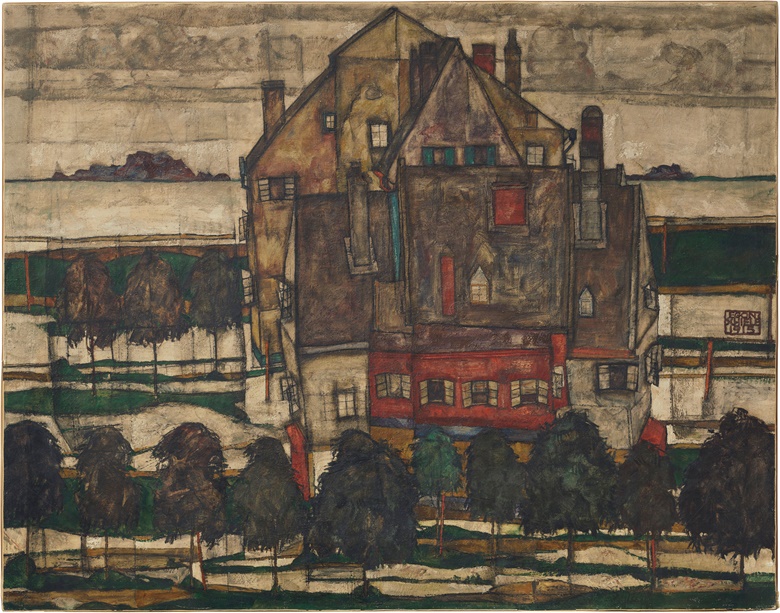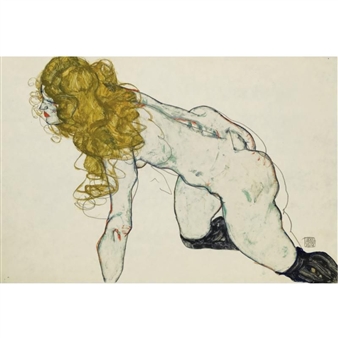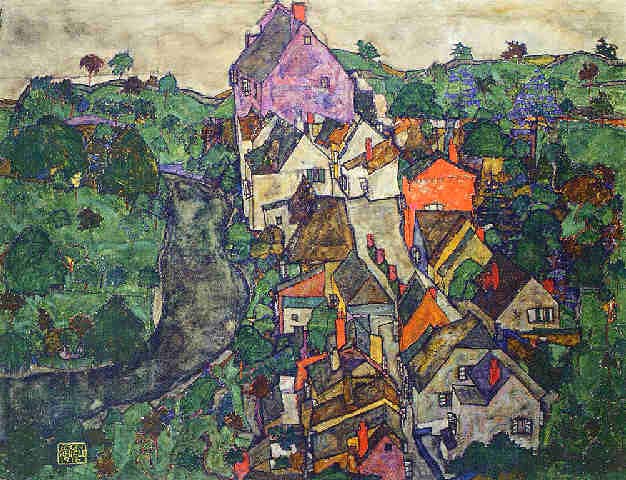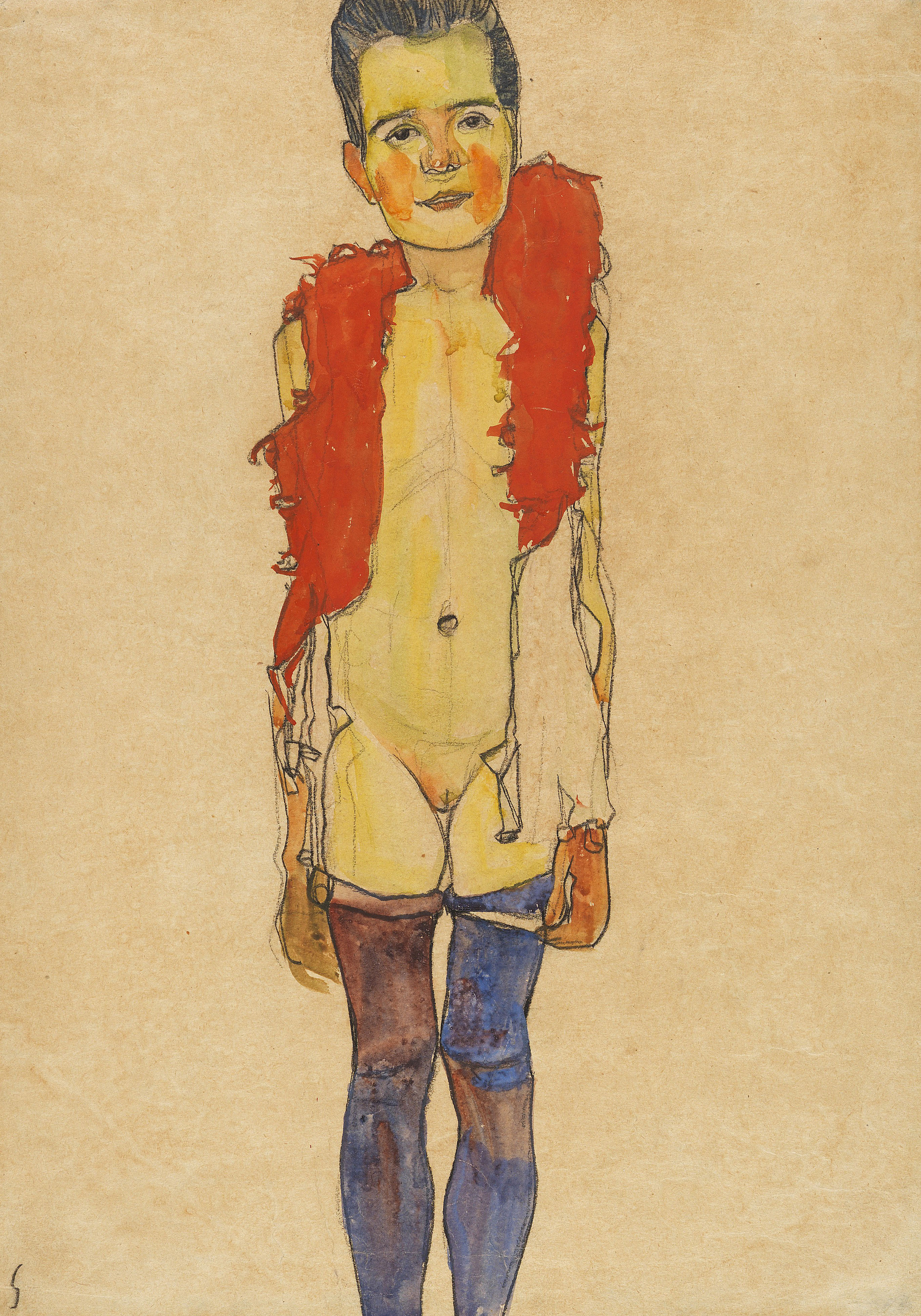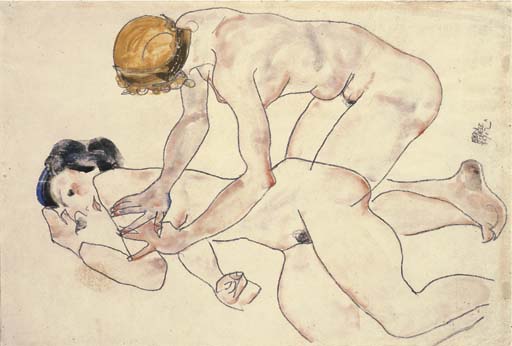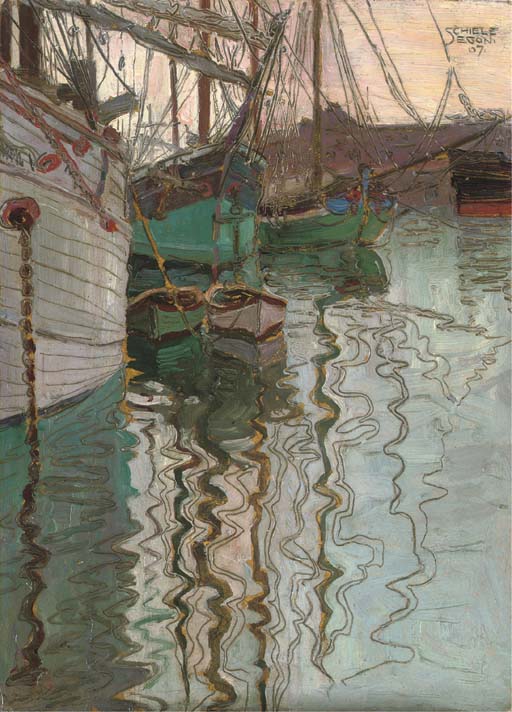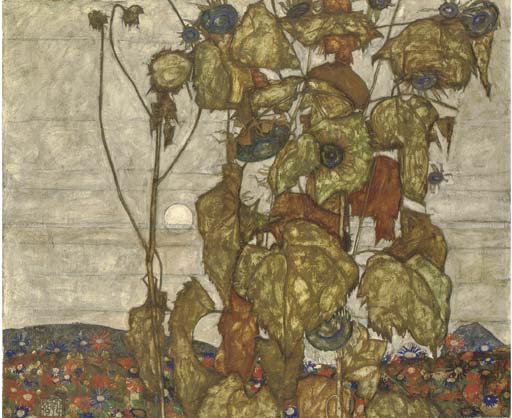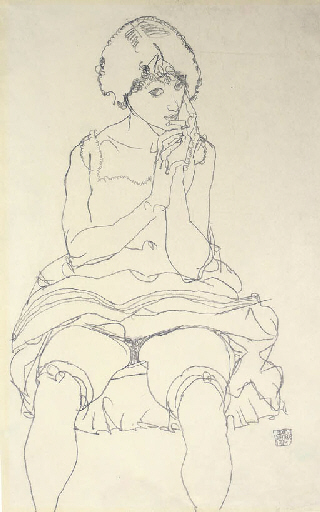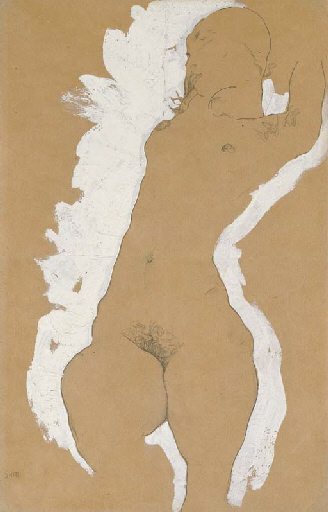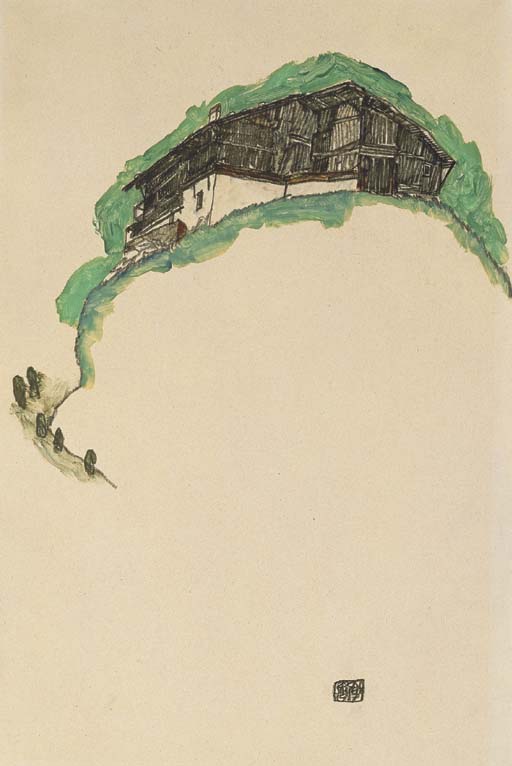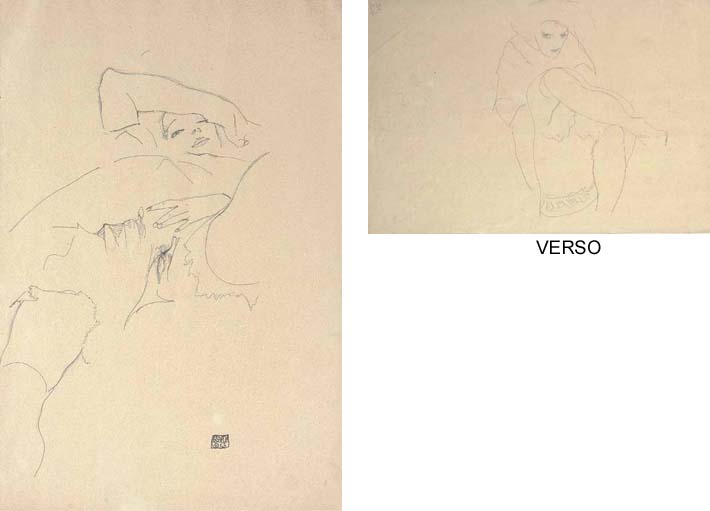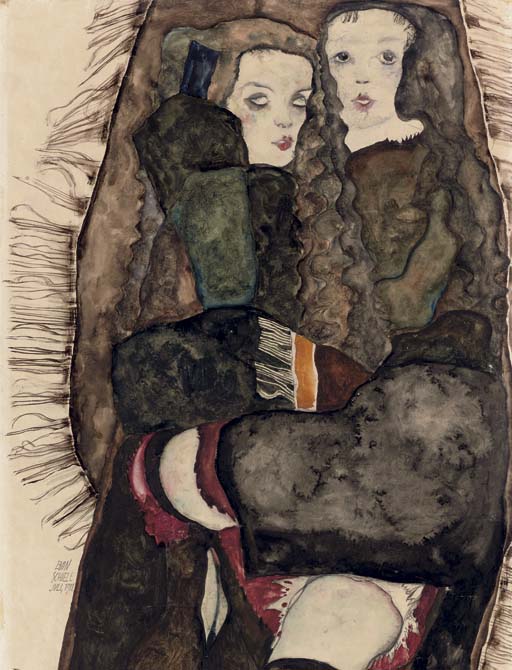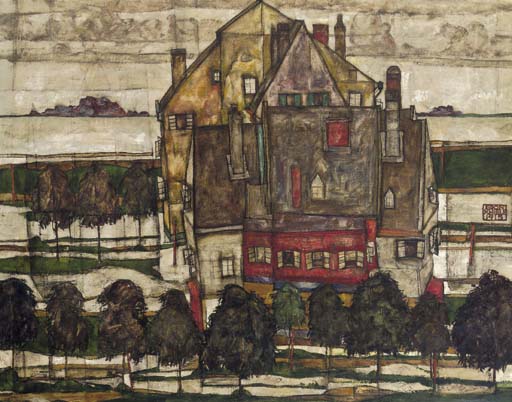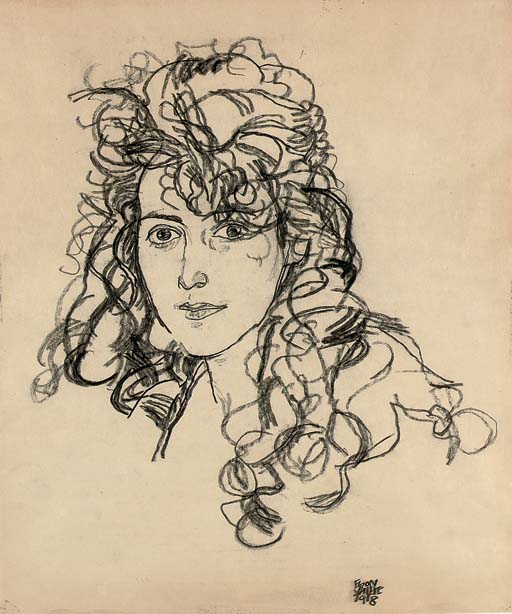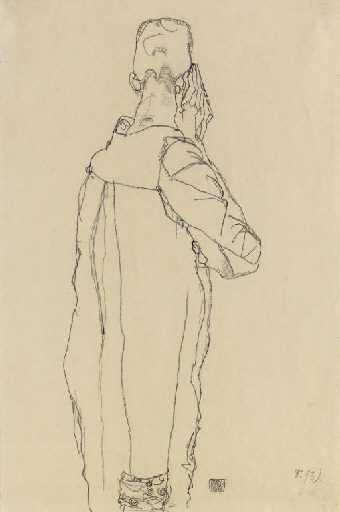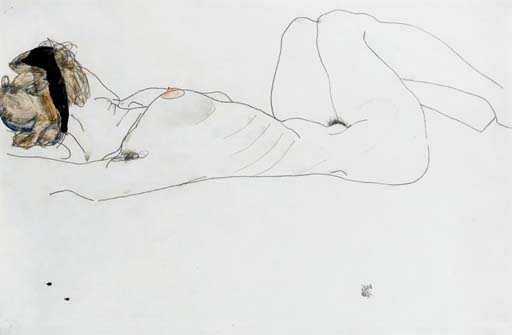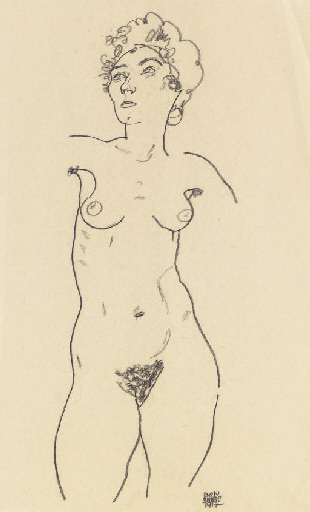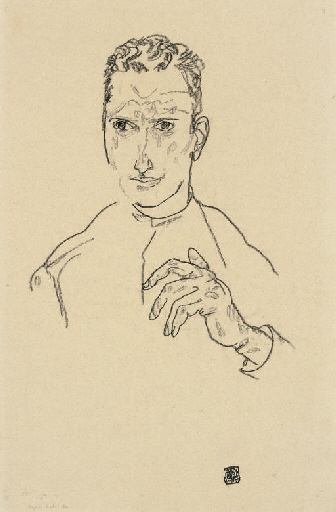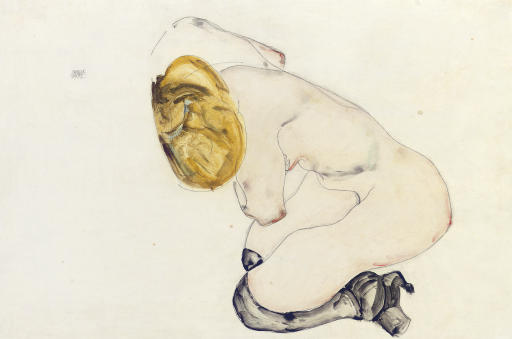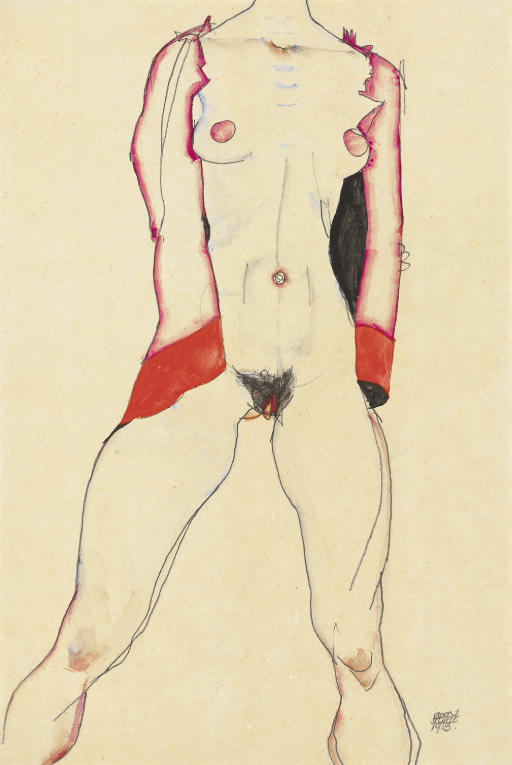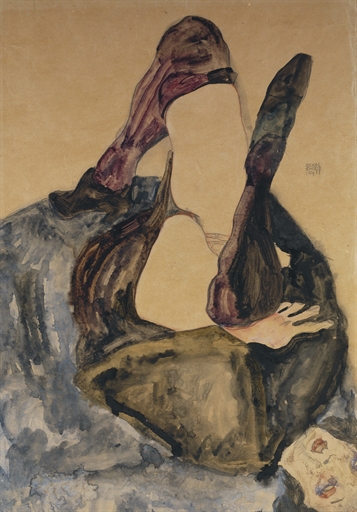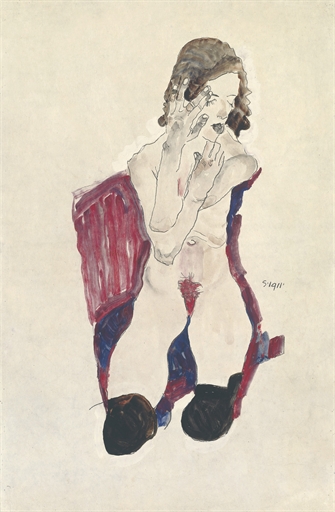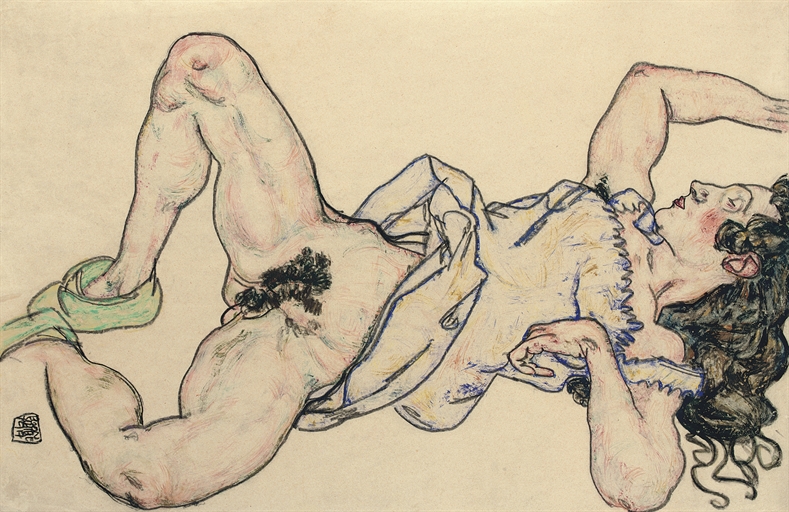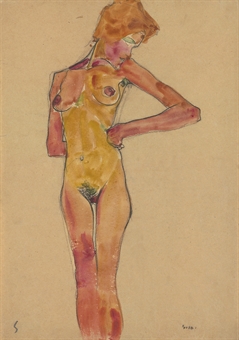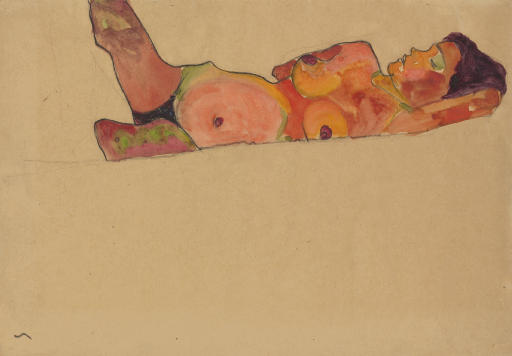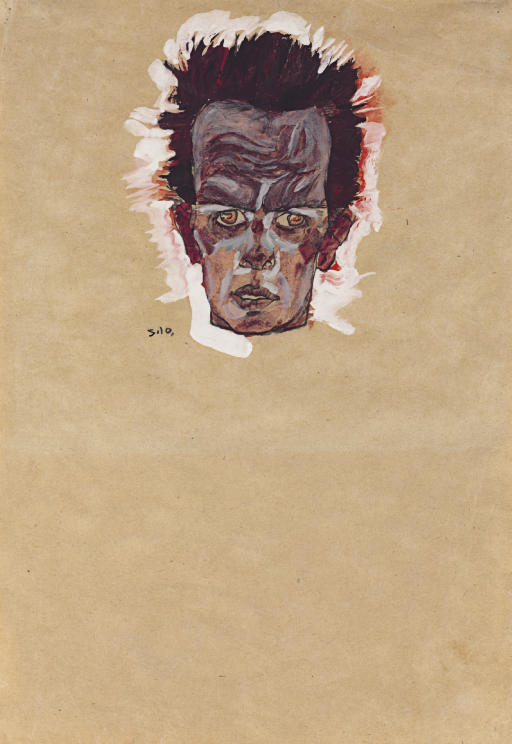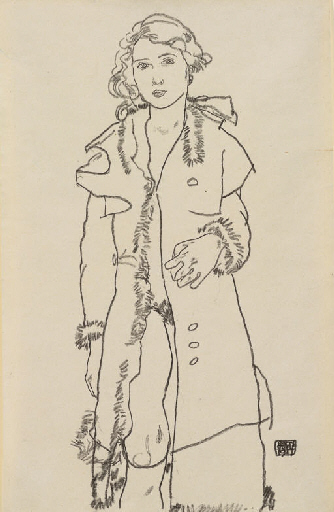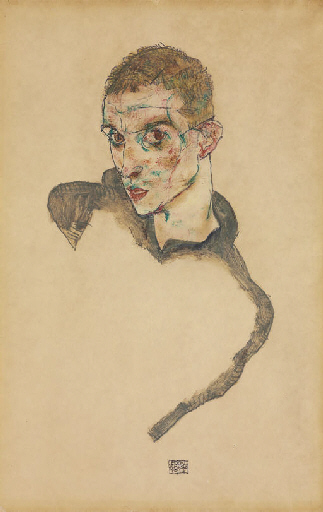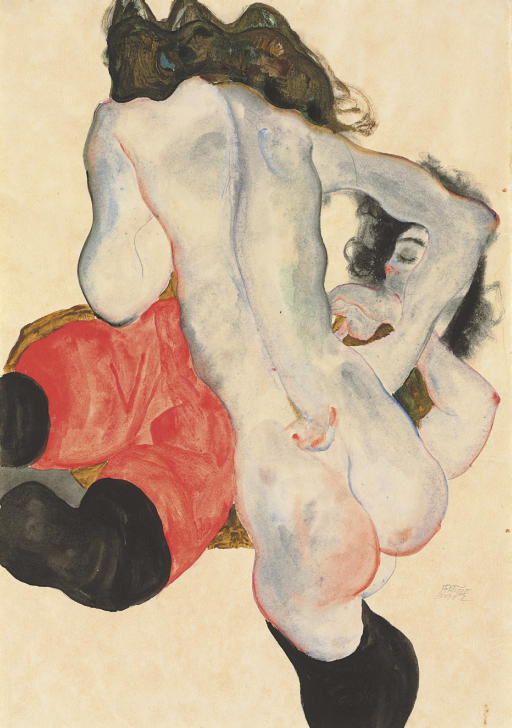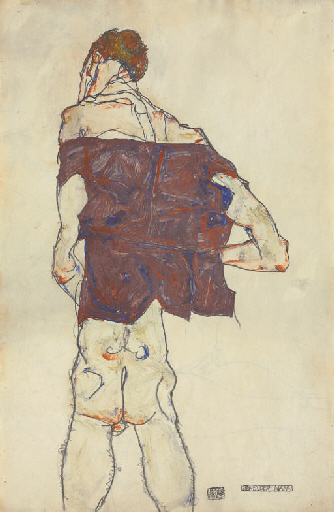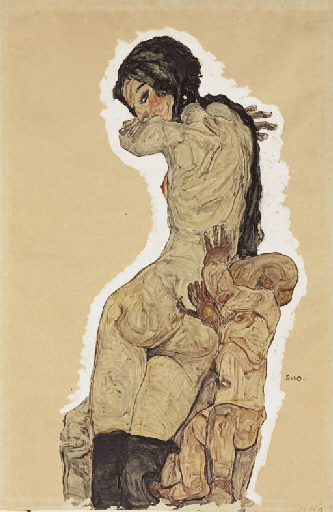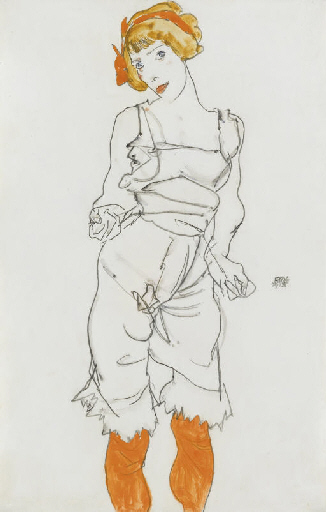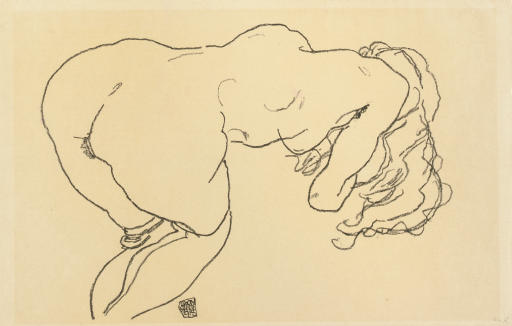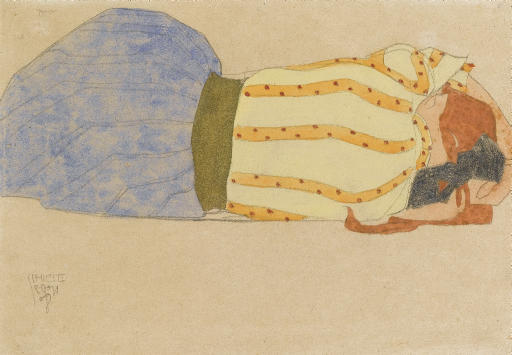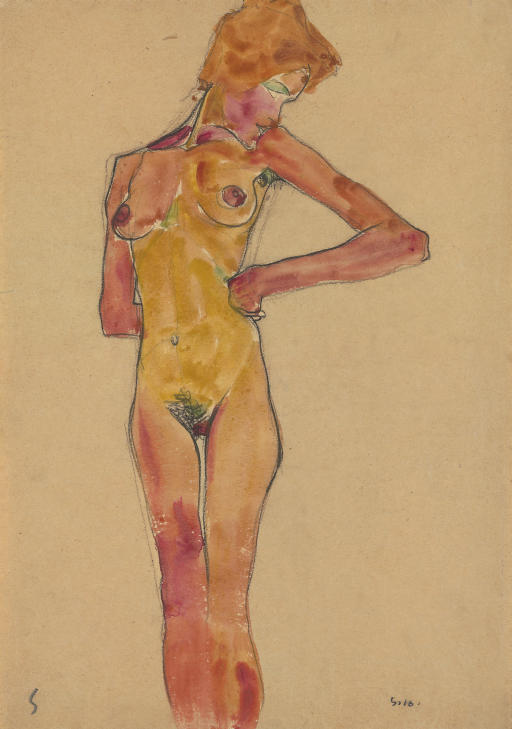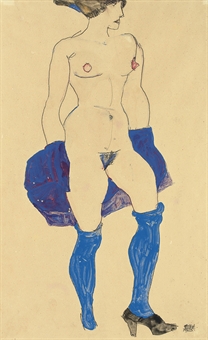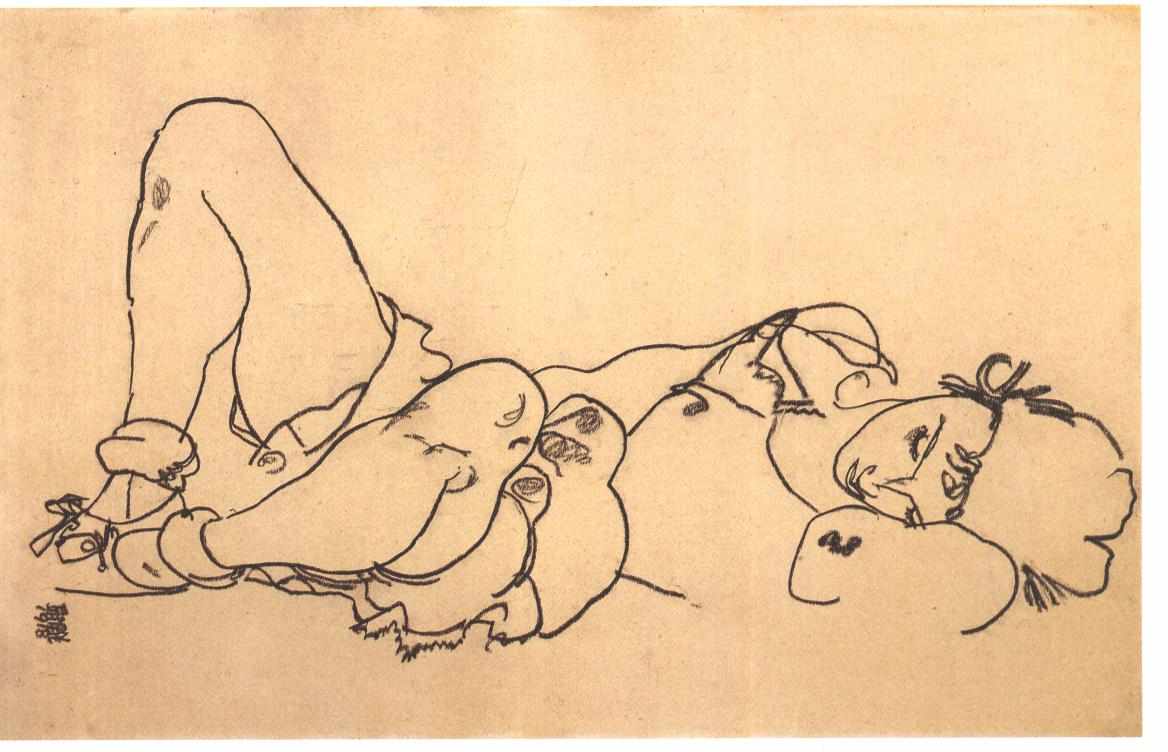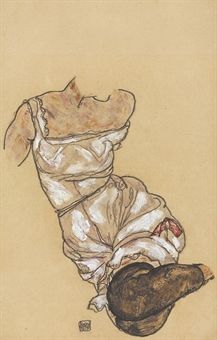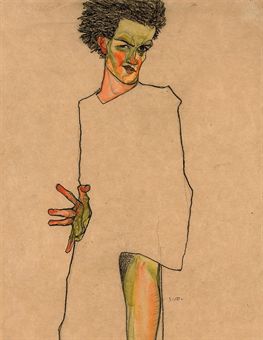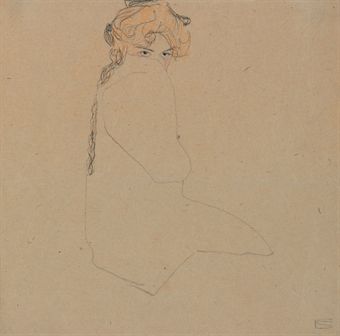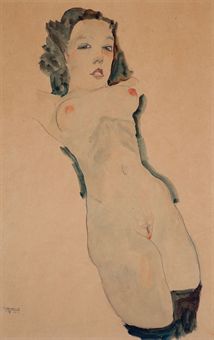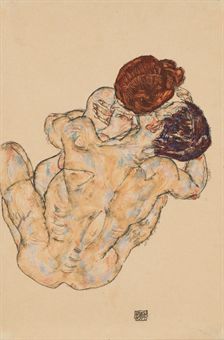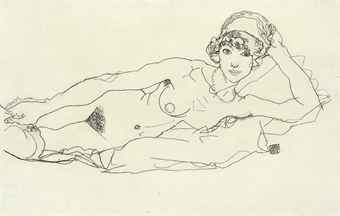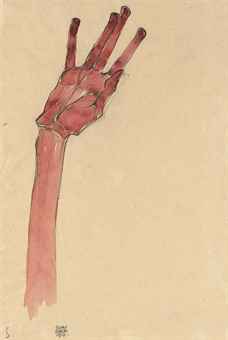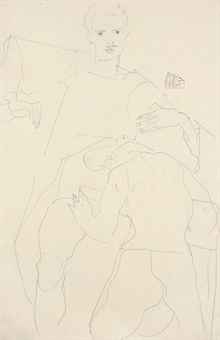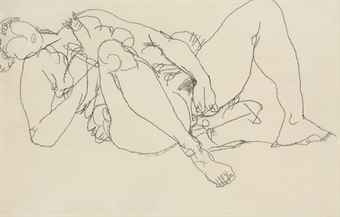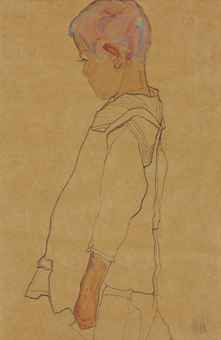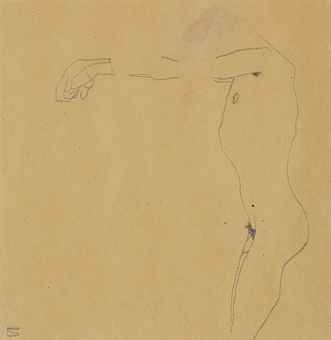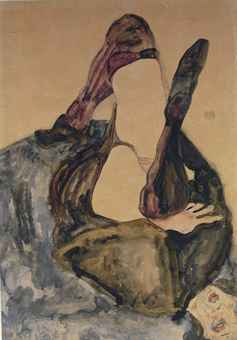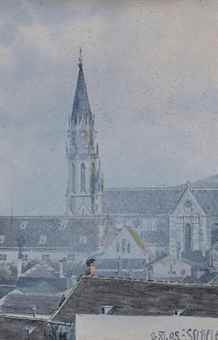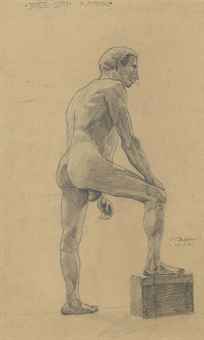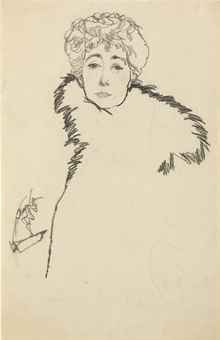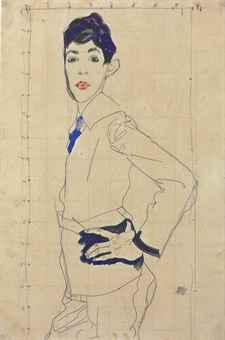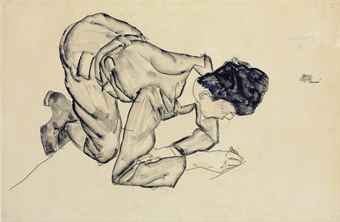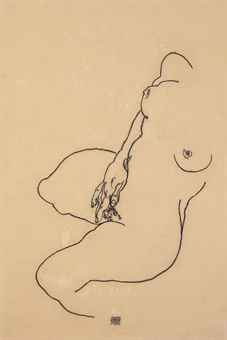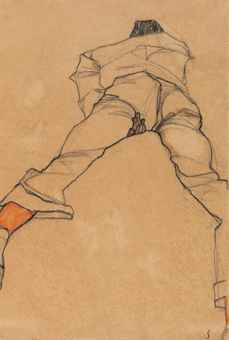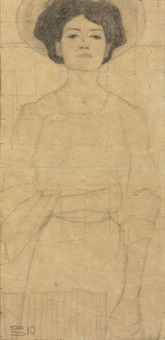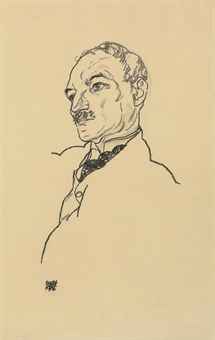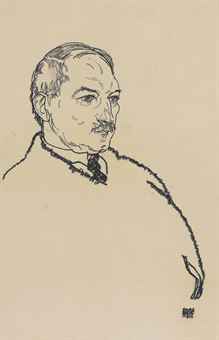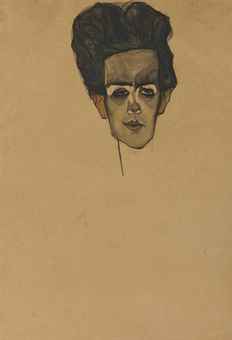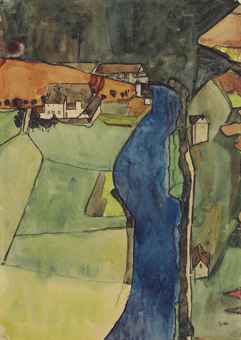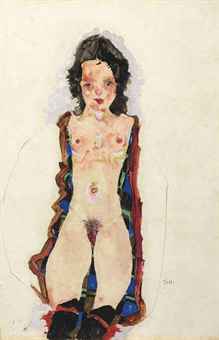Christie's Impressionist and Modern Art on 13 November 2017
Egon Schiele’s Einzelne Häuser (Häuser mit Bergen) (1915, estimate: £20,000,000-30,000,000) is a cityscape used to convey human emotion, expressing the duality of life and decay, nature and humanity.
Schiele created landscapes filled with melancholy, charging the natural world with a deeper spiritual meaning. The autumnal setting of Einzelne Häuser (Häuser mit Bergen) can be seen as a metaphor for mortality; the crumbling facades of the townscape and surrounding trees used as an alternate physical expression of the elemental forces of growth, death and decay.
Einzelne Häuser (Häuser mit Bergen) is one of the finest of Egon Schiele’s great series of psychological landscapes painted in 1915. Depicting an isolated group of distinctly weather-worn houses huddled together against a bleak, open landscape, the painting is one of a magnificent series of landscape visions that articulate a mood of existential melancholy and rank amongst the very best of Schiele’s works.
As with almost all of Schiele’s townscapes, the buildings in Einzelne Häuser (Häuser mit Bergen) appear to represent his mother’s hometown, Krumau, a medieval Bohemian town on the Moldau River, known today as Český Krumlov on the Vltava in the Czech Republic. Schiele painted Einzelne Häuser (Häuser mit Bergen) on the reverse of a fragment of an older picture known as Monk I that dates from 1913. It is believed to have formed part of one of his largest attempted projects, Bekehrung (‘Conversion’), and is linked to the two monumental allegories that he produced the same year, of which only fragments, sketches and photographic evidence are now known.
Christie’s Impressionist & Modern Art Evening Sale on Tuesday 2 February 2016
Selbstbildnis mit gespreizten Fingern (Self-Portrait with Spread Fingers) by Egon Schiele (1890-1918) was painted in 1909, a breakthrough year when Schiele reached creative maturity (estimate: £6-8 million). Although only nineteen years old, Schiele’s prodigious talent had already asserted itself to the point where he had become recognised by Gustav Klimt among others, as one of the greatest hopes for the future of Austrian art. An important early work, this painting reveals Schiele already beginning to move beyond the dominant influence of his mentor Klimt towards a new, more existentially aware expressionist art. With its self-conscious depiction of the artist’s features emerging from a typical gold-ground Secessionist background this work was an announcement of Schiele’s arrival into the contemporary art world of Vienna - a new character taking the stage. Schiele’s first self-portrait oil made for public display, it is a clear statement of how Schiele saw himself as working ‘through’ or ‘by way’ of Klimt and the Seccession, towards a newer more transcendent style of his own.
Previous sale: http://www.christies.com/lotfinder/AAA/AAA-4860121-details.aspx
SOTHEBYS’ SALE of German & Austrian Art February 5, 2007
SOTHEBYS’ SALE of German & Austrian Art February 5, 2007
Egon Schiele’s
Kauernder weiblicher Akt mit blonden Haaren und aufgestütztem linken
Arm (illustrated above) is a powerful and arresting image of a female nude executed
in1914 - the year in which Schiele’s obsession with the naked
form reached its expressive height, when “the rickrack embellishment of
favourite features such as armpits or hair reaches an unprecedented frenzy”
(Jane Kallir).Schiele (1890-1918) relished depicting the curves and contours of
the nude’s anatomy, and the palpable sense of energy that the artist must have
felt as he rendered the form on paper is fully evident in this compelling
rendition of a woman who is at once a femme fatale and a vulnerable human being.
Estimated at £2,250,000-3,250,000 (€3,340,000-4,820,000) the gouache ranks
among the artist’s finest works. Having remained in the same collection since
the 1970s, it had never before been seen in public.
Sotheby’s Impressionist and Modern Art in New York November
7 & 8, 2007.
The sale included a collection of five
spectacular watercolors that come directly from the family of a patron of Egon
Schiele. Property from the Christian M. Nebehay Collection is highlighted by a
riveting self-portrait of the artist - Selbstbildnis mit kariertem Hemd
(Self-Portrait with Checkered Shirt)(est. $4.5/6.5 million). Unlike some of his
self-portraits from earlier years in which he depicts his body entirely in the
nude, he has chosen here to portray himself clothed in a checkered shirt, vest
and tie. No longer the narcissistic, erotically-obsessed adolescent of his
earlier compositions, the artist is depicted here as a self-possessed, mature
adult with emphasis on the psychology of his character, rather than his
physicality. The tilt of his head, the half-open mouth and the unsettling stare
of his hollow eyes deliver a visual impact that is most powerful and confrontational.
Christie's 2017
Egon Schiele’s Einzelne Häuser (Häuser mit Bergen) (1915, estimate: £20,000,000-30,000,000) is a cityscape used to convey human emotion, expressing the duality of life and decay, nature and humanity.
Schiele created landscapes filled with melancholy, charging the natural world with a deeper spiritual meaning. The autumnal setting of Einzelne Häuser (Häuser mit Bergen) can be seen as a metaphor for mortality; the crumbling facades of the townscape and surrounding trees used as an alternate physical expression of the elemental forces of growth, death and decay.
Einzelne Häuser (Häuser mit Bergen) is one of the finest of Egon Schiele’s great series of psychological landscapes painted in 1915. Depicting an isolated group of distinctly weather-worn houses huddled together against a bleak, open landscape, the painting is one of a magnificent series of landscape visions that articulate a mood of existential melancholy and rank amongst the very best of Schiele’s works.
As with almost all of Schiele’s townscapes, the buildings in Einzelne Häuser (Häuser mit Bergen) appear to represent his mother’s hometown, Krumau, a medieval Bohemian town on the Moldau River, known today as Český Krumlov on the Vltava in the Czech Republic. Schiele painted Einzelne Häuser (Häuser mit Bergen) on the reverse of a fragment of an older picture known as Monk I that dates from 1913. It is believed to have formed part of one of his largest attempted projects, Bekehrung (‘Conversion’), and is linked to the two monumental allegories that he produced the same year, of which only fragments, sketches and photographic evidence are now known.
SOTHEBY’S 2003
A
MAJOR landscape by
the great Austrian Expressionist painter Egon Schiele (1890-1918) will be
offered for sale at Sotheby’s in London in June. It has recently been
restituted to the heirs of the original Viennese collectors from whom it was
looted by the Nazis in 1938.
Painted
in 1916, Krumauer Landschaft (Stadt und
Fluss), is a striking and vibrant depiction of the small town of Krumau, on
the banks of the Moldau river in Bohemia. It is estimated to fetch £5-7 million
in the Impressionist and Modern Art Evening sale .(SELLS FOR £ 12.6 MILLION!)
The painting was originally part of the
collection of Wilhelm (Willy) and Daisy Hellmann of Vienna. Willy was a textile
magnate and his wife, Daisy, was a member of one of the most important families
of art patrons in Vienna in the first quarter of the 20th century. The
Hellmanns bought Landscape at Krumau
directly from Schiele, who was a personal friend, soon after it was painted.
The work hung in the Hellmann’s apartment until October 1938 when it was seized
by the Nazis and put up for sale in Vienna in 1942. It was bought by Wolfgang
Gurlitt who sold it to the Neue Galerie in Linz in January 1953, where it has
been on public display until its restitution earlier this year.
The
painting’s history came to light following research by Lucian Simmons, Head of
Sotheby’s Restitution department and Andrea Jungmann, Head of Sotheby’s
Austria. Their efforts were coordinated with those of the Jewish Community in
Vienna, who were instrumental in achieving the painting’s return to its
rightful owners.
Schiele
had close links with the town of Krumau. It was his mother’s birthplace and a
refuge for the artist at various times in his troubled life. Schiele brings a
distinctive, vertiginous style to this dynamic vision of his maternal home
town. Against a background of verdant green hills, the houses are painted from
an unnaturally high vantage point as if stacked up one upon the other with
their bright orange-red and brown roofs, while the river snakes through the
composition with the sinuous curve of a woman’s body.
Tragically
in 1918 at the age of just 28, Schiele fell victim to the Spanish flu epidemic
that spread throughout Europe.
Krumauer Landschaft, executed in 1916, epitomises his
unique contribution to the development of modern art in the first decades of
the 20th century and is one of the greatest townscapes from the last years of
his career.
Ketterer Kunst 2015
Immoral and depraved or just explicit and simply different? What earned the artist disrepute in the early 20th century makes him one of the greatest protagonists of Viennese Expressionism. Now his masterpiece "Mädchen mit Federboa" will be called up in the auction of Modern Art / Post War / Contemporary Art at Ketterer Kunst in Munich, Germany from 3 - 5 December, 2015.
The frontality and permissiveness of the nude from 1910, coupled with an unsparing aggressive coloring, neither matched contemporary taste and aesthetic principles nor prevailing morals. Accordingly, it was no surprise that this work was seen as a provocation. However, the year 1910 saw great progress in the development of Schiele's stylistic means, which found expression in an intensified coloring and the figures' positioning in front of an undefined blank background. Early that year Schiele contoured his models with strong lines of charcoal, while he made increasing use of the pencil later on; he also put less emphasis on a detailed illustration of the carnation than he used to, instead he preferred a more intensive treatment of face and hair. Additionally, the choice of young and impatient models forced the artist to a more spontaneous and liberal performance. Half way into the year, Schiele began to experiment with gouache colors, which, as it is the case in our work, he used to accentuate draperies and cloths. Accordingly, this nude, estimated at € 600,000-800,000, is a prime example of the artistic progress Egon Schiele made in this time.
Egon Schiele, Mädchen mit Federboa Watercolor, opaque paint and chalk, around 1910. 43,5 x 30,5 cm / 17.1 x 12 in. Estimate: € 600.000-800.000 / US$ 660,000-880,000.
Ketterer Kunst 2014
Sotheby's 2015

Egon Schiele, Stehender Akt mit weissen Tuch, Gouache and watercolor over pencil on paper $1,390,000 (£903,477)
Sotheby's 2014
LOT SOLD. 1,325,000 USD
Ketterer Kunst 2015
Immoral and depraved or just explicit and simply different? What earned the artist disrepute in the early 20th century makes him one of the greatest protagonists of Viennese Expressionism. Now his masterpiece "Mädchen mit Federboa" will be called up in the auction of Modern Art / Post War / Contemporary Art at Ketterer Kunst in Munich, Germany from 3 - 5 December, 2015.
The frontality and permissiveness of the nude from 1910, coupled with an unsparing aggressive coloring, neither matched contemporary taste and aesthetic principles nor prevailing morals. Accordingly, it was no surprise that this work was seen as a provocation. However, the year 1910 saw great progress in the development of Schiele's stylistic means, which found expression in an intensified coloring and the figures' positioning in front of an undefined blank background. Early that year Schiele contoured his models with strong lines of charcoal, while he made increasing use of the pencil later on; he also put less emphasis on a detailed illustration of the carnation than he used to, instead he preferred a more intensive treatment of face and hair. Additionally, the choice of young and impatient models forced the artist to a more spontaneous and liberal performance. Half way into the year, Schiele began to experiment with gouache colors, which, as it is the case in our work, he used to accentuate draperies and cloths. Accordingly, this nude, estimated at € 600,000-800,000, is a prime example of the artistic progress Egon Schiele made in this time.
Egon Schiele, Mädchen mit Federboa Watercolor, opaque paint and chalk, around 1910. 43,5 x 30,5 cm / 17.1 x 12 in. Estimate: € 600.000-800.000 / US$ 660,000-880,000.
Ketterer Kunst 2014
Egon Schiele
Liegender weiblicher Akt mit angezogenen Beinen, 1913.
Gouache
Estimate:
€ 300,000 / $ 321,000
Sold:
€ 937,500 / $ 1.003.125 Sotheby's 2015

Egon Schiele, Stehender Akt mit weissen Tuch, Gouache and watercolor over pencil on paper $1,390,000 (£903,477)
Sotheby's 2014
LOT SOLD. 1,325,000 USD
LOT SOLD. 7,881,250 GBP
Sotheby's 2007
Christie's 2008
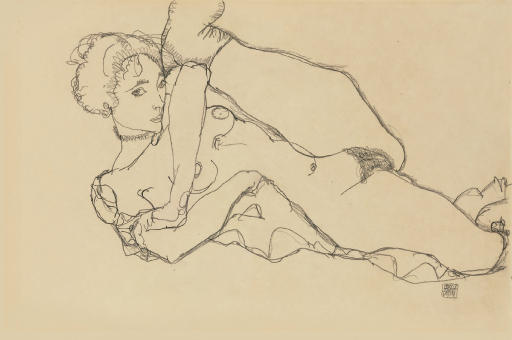
Christie's 2009
Christie's 2010
Christie's 2011
Christie's 2012
Christie's 2013
ARTISTS AND PROPHETS. A SECRET HISTORY OF MODERN ART 1872-1972
Egon Schiele
Young Man in Purple Robe with Clasped Hands, 1914Egon Schiele
Self-Portrait with Lowered Head, 1912
The starting point for the exhibition is the birth of a movement of
artist-prophets in the German-speaking region around 1872. The
protagonists were regarded not only as religious dissenters, but also as
social revolutionaries. Their real aim was to bring about a change in
the lifestyles and perspectives of their fellow human beings in hopes of
empowering them to overcome individual, social, and economic problems.
The best known of these artist-prophets were Karl Wilhelm Diefenbach,
Gusto Gräser, Gustav Nagel, Friedrich Muck-Lamberty, and Ludwig
Christian Haeusser. Each of them possessed considerable charisma and
felt called upon to disseminate his revelations to the people, not for
purposes of material gain, but for their own good. Although the first
three of these men lived on the fringes of society in their time,
Muck-Lamberty and Haeusser, both students of Gräser, attracted huge
flocks of followers in the 1920s—until the National Socialists took
power. By that time, all five prophets had attained legendary status.
That they are scarcely remembered today is largely attributable to the
fact that little attention has been paid to the irrational in
German-speaking Europe since the Enlightenment. Yet these charismatic
leading figures were not only well-known in avant-garde circles, but
also had a profound impact on modern art in Europe. The path-breaking
abstract art of a František Kupka, for example, can be traced to his
contact with Diefenbach and his disciples.
Much the same can be said of
one of the great themes in the art of Egon Schiele: the artist as
prophet. Since 1905, Johannes Baader’s Dadaist actions and collages were
closely linked with his self-image as a modern-day Christ—a standpoint
and position that was encouraged by Nagel, the “Apostle of Jesus.” The
subversive drawings executed by Friedrich Schröder-Sonnenstern after
1945 were inspired by his lesser-known activities as a prophet during
the Weimar Republic. In the 1950s, Friedensreich Hundertwasser
positioned himself as an artist-environmentalist, wandered to the most
distant corners of the world, and created works of penetrating, holistic
radiance for a broad public. The messianic character of Joseph Beuys’s
artistic mission was also sustained by principles espoused by the
prophets. And Jörg Immendorff was encouraged by them to take his “LIDL”
art to the streets of Düsseldorf and profess his belief in the religion
of communism.
